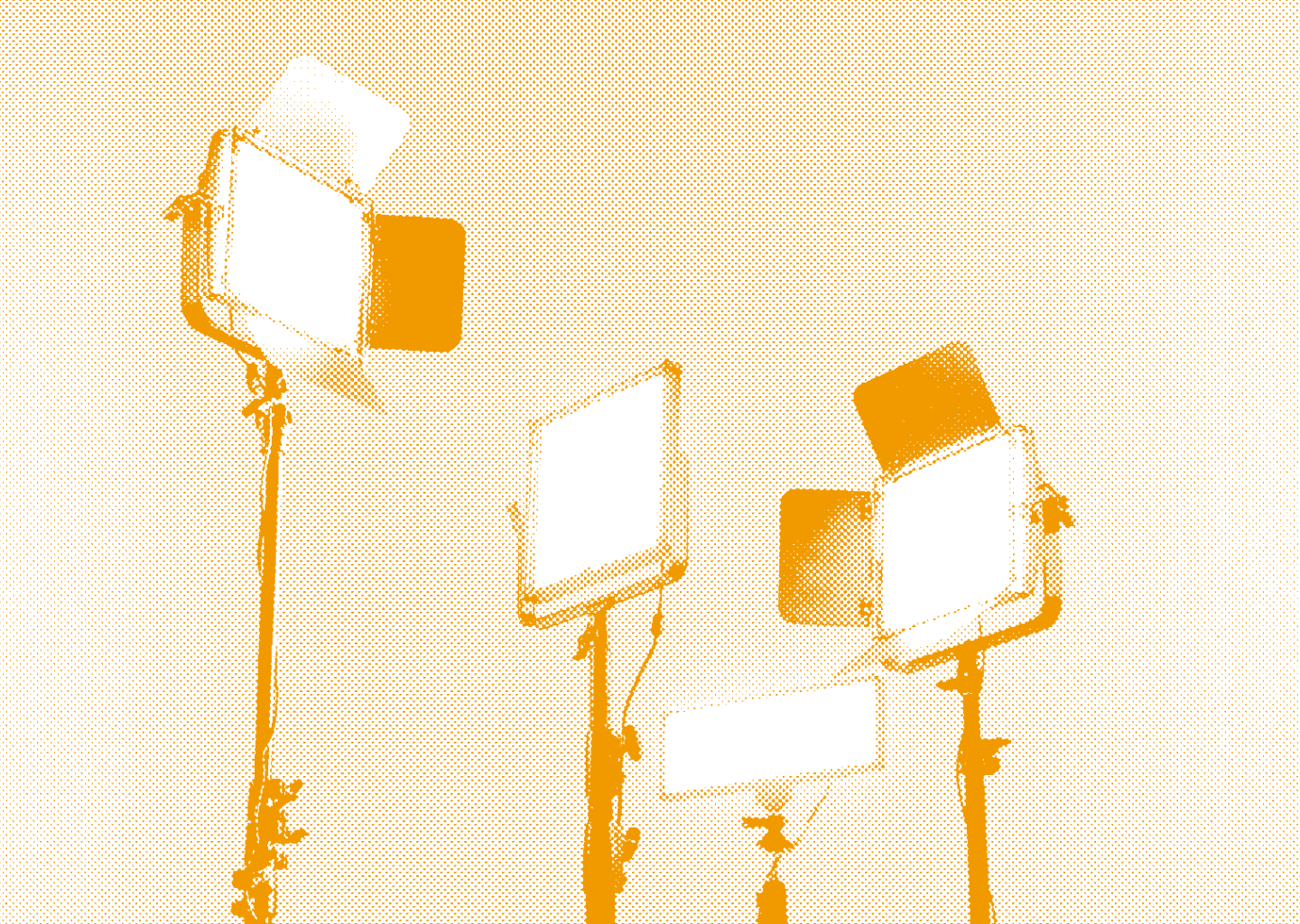
Lighting
CHAPTER 1 / INTRODUCTION
The section “Make your own opera” is aimed at students within and without the school setting, the educational community, and all those who like opera and the performing arts in general and would like to dare to create and stage their own performance. It is not a guide containing concrete steps or methodologies you need to follow to make your own show; “Make your own opera” is rather a source of inspiration, a section offering information that can surely be useful to you throughout the process, a section that aspires to make you feel creative without being preoccupied with whether or not you have the appropriate space, human resources or means. It is an educational tool that you can use for prearranged school celebrations – by implementing specific chapters of the provided material –, a big final presentation at the end of the school year, a performance you want to stage with your class, or even for your classes as part of the curriculum, starting from just one chapter. The stage that is hidden in your class is waiting for you to reveal it.
So make your own opera performance, and don’t get scared off by the title. Remember that opera constantly transforms and has a lot to teach you!
This chapter is dedicated to lighting. A field that is as technical as it is artistic. In practice, a lighting designer should be both a creator and a technician. While they should be able to understand the work and produce a lighting design that will create atmospheres and an environment that serves the text and the direction, they also need to have electrical skills.
Lighting is one of the most important aspects of a work of the performing arts. Its role in a performance may extend even further to encompass features of stage architecture, visual composition, dramaturgy and direction.
With the evolution of technology and the recognition of this field’s significance, a lighting designer not only has to light the stage and the characters on it, but, by employing light’s qualities, possibilities and functions, they are also called upon to “impact” the actors, objects and stage space, creating environments and worlds for the stories of every performance. As mentioned in the introduction, the lighting designer’s discipline is as artistic, as it is technical. At first, the lighting designer needs to act and operate as an artist, having a full understanding of all the components of a show (text, direction, music, costumes, sets, dancing), as well as the aesthetic, balance and effect of lighting on the human mental state. At the same time, however, they also need to have knowledge of technical issues related, for example, to lighting equipment and technology, and the visual perception and function of the human eye.
Put plainly, to understand all the dimensions of this artistic field, we need to think that in reality a lighting designer tells a story of a work through light. So, to be able to tell this story, they need to make a scenario within the already existing story of the work, a lighting script that needs to converse with all the components and materials of the show. Using light as a main material and through the lighting sources available to them (lighting equipment, natural light, stage props serving as lighting sources), the lighting designer makes use of light’s qualities and traits (intensity, form, movement, direction, colour), creating their own score, their own scenario about the progression of light’s story within the show. To understand how important in a performance light is, think of the impact the colour of lighting can have on the audience’s state of mind, for example imagine you are in a theatre hall and suddenly all the lights go out. Do you feel fear? Anxiety? Do you hold your breath? How do you think you would feel?
Below, let’s explore some possible ways of approaching a lighting designer’s creative process, as well as some suggestions for instances where lighting equipment is unavailable.
- Reading the text & listening to the work’s music
- Drafting a lighting design proposal
- Discussing with the director and the artistic team & attending rehearsals
- Finalizing the lighting design
CHAPTER 2 / POOL OF IDEAS
Whether you are in a group setting or a school classroom, you can choose the way you want to work, either collectively, or divided into sub-groups, or even individually, designating a member of the group or pupil for each specialty
Reading the text & listening to the work’s music
Like in all the other opera-related fields, so in lighting, the first and most fundamental stage of the creative process is the reading of the text. Reading and analyzing the text is an extremely significant tool for a lighting designer. To be able to create their own concept, their own lighting story, they need to understand the work, have a grasp of the where and when it is set, the style and emotions of the characters, so that they can convey the work’s atmosphere and feelings to the audience. In this stage, the lighting designer can work with the director, to achieve a more correct and thorough reading and analysis of the work. At the same time, in works of the performing arts such as opera, music theatre and musical, it is equally important for a lighting designer to study the work’s music, which, just like the text, serves as a critical tool for communicating the work’s message.
Drafting a lighting design proposal
In this stage, after examining the musical and textual aspects of the work, the lighting designer has to create their initial concept. Through studying and doing research on the work, as is also the case with all the other opera-related professions, the lighting designer needs to draft an initial lighting design proposal, which they will then communicate to the director and the artistic team. To be able to draft a lighting design proposal that can be implemented, the lighting designer needs to know where the performance will be staged, what possibilities this space provides, as well as the equipment available. In a setting such as the classroom, where in most cases there is no lighting equipment available, the lighting designer has to examine the venues to see if there are any windows, how the light streams into the classroom depending on the time of day we would like to schedule the performance for, if there are blackout curtains, what other means/objects could be used as lighting sources etc.
Discussing with the director and the artistic team & attending rehearsals
When the initial lighting design proposal is ready, it should then be communicated to the director and the entire creative team. The lighting designer shares and presents their lighting design proposal and has to be open to listen to new ideas and suggestions from all the members of the creative team, based on the goals of each professional. They also need to discuss, possibly disagree, and then to process all of the ideas, before coming up with their final lighting design. This stage is extremely important for preparing the final version. The lighting designer has the possibility to see the text come to life and take shape during rehearsals, listen to the work’s music being performed live, examine the stage set and props, and observe the movement of the actors on stage. By attending the rehearsals until the moment they will have to light the performance, a lighting designer has the time to process all the aspects of the performance and the images created on stage, before they finalize their lighting design.
Finalizing the lighting design
At first, a lighting designer needs to reflect on the light’s purpose and role in each scene, and based on this decision, to provide the final lighting design of the performance. Do they want to use light through a lighting source that is there as part of the stage set? Do they want to depict the time, place, mood and atmosphere? Do they want to create clearly realistic images with the light, for example a sunset? Or do they want to use the light symbolically? Certainly, there are more than one ways to do things, and surely they can make use of all of these possibilities. The most important thing however, is to know the reason why they have chosen to go in a particular direction, as their decision will define the audience’s overall experience.
As mentioned earlier, during the lighting design creation stage, you need to take the following points into consideration:
Colour
The choice of different colours for the lights can evoke different moods. Every colour can have an imprint on the audience’s emotions and the interpretation of the work’s message. Colour can serve both a realistic and metaphorical/symbolical function in the work. If, for example, we want to portray a fire in a scene, we can choose the colour red that is associated with flames. On the other hand, more abstractly, in a scene where we want to convey a warmer atmosphere to the audience, we can choose yellow lights, which refer to sunlight and can evoke a sense of warmth for the viewers.
*Extra tip.
When choosing a certain colour of lights, we need to check how this colour is being reflected onto the stage set’s surfaces and the costumes of the show.
Intensity
The intensity of the light, namely the intensity of its brightness, is one more characteristic you should keep in mind while preparing the lighting design. The levels of intensity will help you create the visual effects you want and will allow you to evenly distribute the light across the characters, objects and the whole stage.
Focus
The focus of the light is a key characteristic in lighting design. In a school setting that most likely doesn’t have any lighting equipment, it is hard to adjust the focus of a lighting source. However, by choosing specific lighting sources (e.g. flashlights, lamps) and defining the position and distance of a lighting source from the point you want to light, you can determine the size and focus of the light beam.
Shadow
Another key characteristic of a lighting design are shadows. By creating shadows, through the use of either lighting sources or natural lighting, you can evoke intense atmospheres and moods, influencing and even building a character’s personality. Imagine a play where there is a mysterious and enigmatic character – how would it feel like if this character emerged from the shadows?
Position
One more extremely important factor you need to keep in mind when creating a lighting design is the position of lighting sources. The light can emanate from various directions, such as the front, back, side, below, or above. On a theatre stage there is usually the possibility to place the lighting sources in all these positions, yet in a classroom or even in a bigger space, where the lighting sources are limited, you can choose two positions, or maybe just one.
ACTIVITY / LIGHTING
In this chapter, instead of activities you will find some suggestions for lighting sources
Before starting to prepare any lighting design, take into account all the facts and available materials. Surely the possibilities in a classroom are not the same with those you would have in a theatre hall. No problem! Moreover our knowledge on lighting design is limited, so what do we do? We improvise and experiment with those things we do have and those we can find easily. And let us not make a big deal out of it, we don’t need much. One or two smart ideas are enough to get you started!
Light coming through the windows
Before even starting to search for lights, look around you and answer the following questions:
- Does the space where the performance will take place have access to natural light?
- Are there any windows?
- What happens with the light that’s coming through the windows during rehearsals and at the time when the performance will take place? (Notice! If you choose to use the light coming through the window, you need to schedule some rehearsals at the time of day when the performance will take place, so as to have a clear picture of how it looks.)
- Are there any curtains hanging from the windows? (In case you are interested in filtering the light or creating a blackout)
After finding the right spot to set up your stage in the classroom, experiment with the light coming through the windows. Observe how and where the light falls upon and if you are interested in making use of it, in collaboration with the director, arrange the positions of the actors, objects and action on stage depending on the light.
Projector
The projector, a tool available in many schools, can be an exceptionally important source of lighting for your performance.
- Find the right place
- Use the diaphragm and focus wheel
- Use colour filters (transparent coloured plastic sheets)
- Use materials to produce visual effects (e.g. flour in front of the lens, etc.)
Light fixtures
You can also employ lighting sources that we use in our everyday lives, such as:
- Desk lamps
- Floor lamps
- Christmas or decorative lights
- Other sorts of lighting sources (battery-powered lamps etc.)
You can make use of all of the above lighting sources safely and with caution, and can even use them as stage props.
Flashlights
Flashlights are another lighting source that you can easily have access to. Flashlights come in different sizes, from very small ones to very big ones, which you can use as spotlights. Just like with light fixtures, you can also use flashlights both as lighting sources and as stage props that will be managed by the actors.
Materials that can serve as filters in front of lighting sources
Transparent plastic bags, thin fabrics, plastic, rice paper, curtains, and anything else you can imagine could be used as filters for the lighting sources you will choose, and at the same time – if the team wishes so – as parts of the set.
Other lighting sources
- Glow sticks, used for fishing or camping
- Glow sticks for parties
- Fluorescent duct tapes
- Laser
You could also think of other objects that could be used to produce lighting during your performance.
VIDEO
While exploring the above ideas, suggestions and steps, feel free to experiment with developing a lighting design for a work of the performing arts. To get more ideas you can watch Eleni Houmou in the video below sharing with you relevant information, as well as her own experience as a lighting designer in opera and music theatre works.
Εleni Houmou talks about her experience as a lighting designer in opera and music theatre works. Video produced by Odd Bleat.



